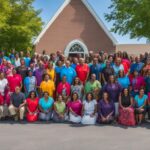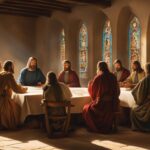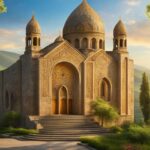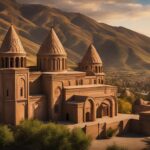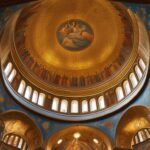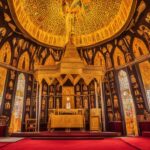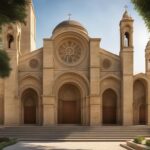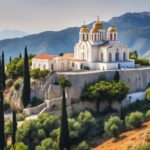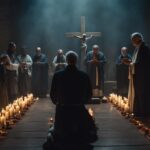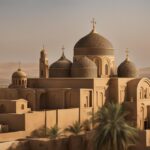The Syriac Orthodox Church, also known as the Syriac Orthodox Christianity, is a venerable institution with a rich history. Its origins can be traced back to the early followers of Jesus in Antioch, making it one of the oldest established apostolic churches in the world. The church has faced challenges and persecution throughout the centuries, but it has remained steadfast in its faith and traditions.
The Syriac Orthodox Church has been a beacon of Semitic Christianity, preserving its unique identity and beliefs. The church’s liturgy, conducted in the Syriac language, adds a distinct flavor to its worship practices. With its strong roots in the Middle East, India, and the diaspora, the Syriac Orthodox Church has become a vibrant and multiethnic community, embracing believers from diverse backgrounds.
This article explores the fascinating history, beliefs, and practices of the Syriac Orthodox Church. From its origins and early establishment to its sacraments and rituals, leadership and clergy, worship practices, and sacred texts, we delve into the various aspects that define this ancient faith community. We also examine the denominations and sects within the Syriac Orthodox Church and touch upon contemporary issues and challenges it faces today.
Key Takeaways:
- The Syriac Orthodox Church is one of the oldest apostolic churches, tracing its roots back to the early followers of Jesus in Antioch.
- The church follows a Semitic form of Christianity and conducts liturgy in the Syriac language.
- The Syriac Orthodox Church has seven sacraments and places a strong emphasis on worship and participation of the faithful.
- It is led by the Patriarch of Antioch, who holds apostolic succession from St. Peter, and has a hierarchy of bishops and priests.
- The Peshitta version of the Bible is considered sacred in the Syriac Orthodox Church, and the church has made significant contributions to biblical translations and interpretations.
Origins and Early Establishment
According to ecclesiastical tradition, the Syriac Orthodox Church traces its origins back to the early Christian community in Antioch, where the followers of Jesus were first called Christians. It was in this vibrant city that St. Peter the Apostle established a bishopric, solidifying the foundations of the church.
The apostolic era marked a period of extraordinary growth and development for the Syriac Orthodox Church. Under the leadership of successive bishops and patriarchs, the church flourished, becoming an influential center of Christianity in the region.
From its inception, the Syriac Orthodox Church played a crucial role in the spread of the Christian faith. Its close connection to the Apostolic era and the church of Antioch, where St. Peter served as the first bishop, bestowed upon the Syriac Orthodox Church a sense of authenticity and authority.
Syriac Orthodox Church in the Apostolic era
“The Syriac Orthodox Church can trace its roots back to the very beginnings of Christianity. As a part of the apostolic era, the church’s early establishment in Antioch signifies its close ties to the teachings and disciples of Jesus himself.”
The Syriac Orthodox Church’s early establishment in Antioch positioned it as an essential center of Christianity, contributing to the development and preservation of the faith. Despite challenges and persecution throughout the centuries, the church remained resilient, embracing its Semitic heritage and the Syriac language as a distinctive element of its worship.
The Syriac Orthodox Church’s origins in the apostolic era serve as a testament to its enduring faith and its commitment to preserving the traditions passed down by the early Christian community.
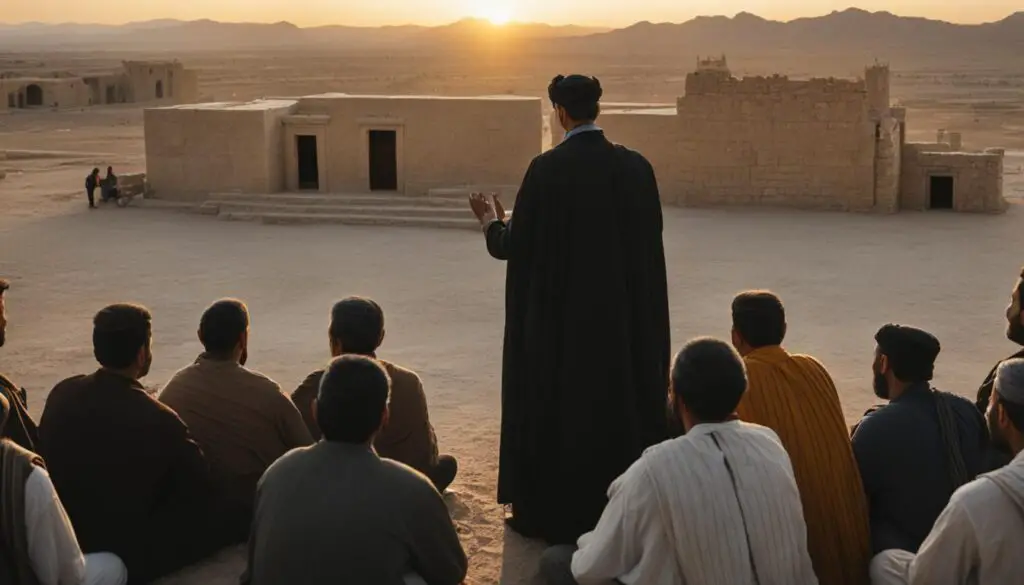
Key Points:
- The Syriac Orthodox Church traces its origins back to the early Christian community in Antioch.
- St. Peter the Apostle established a bishopric in Antioch, laying the foundation for the church’s early establishment.
- From its inception, the Syriac Orthodox Church played a significant role in the spread and development of the Christian faith.
- The church’s close ties to the apostolic era and the church of Antioch added to its authenticity and authority.
- Despite challenges, the Syriac Orthodox Church has thrived, embracing its Semitic heritage and preserving the use of the Syriac language in its liturgy.
Beliefs and Doctrines
The beliefs and doctrines of the Syriac Orthodox Church are rooted in its unique understanding of Christology and its rejection of the teachings of the Council of Chalcedon. Central to the church’s beliefs is the concept of miaphysitism, which asserts that Christ has one incarnate nature from two natures, human and divine.
Unlike the Chalcedonian teaching that Christ has two distinct natures, the Syriac Orthodox Church affirms the unity of Christ’s nature while acknowledging the fullness of his divine and human attributes. This belief in the inseparable union of the divine and human in Christ is a fundamental tenet of the Syriac Orthodox faith.
The council of Chalcedon, held in 451 AD, played a significant role in shaping the Christological beliefs of various Christian denominations. However, the Syriac Orthodox Church rejected the council’s formulations, leading to its separation from the Byzantine Church and other Chalcedonian churches.
“In the Syriac Orthodox Church, we affirm that Christ is both fully God and fully human, without division or confusion in his being. Our understanding of Christology emphasizes the unity of nature, while recognizing the distinctions between the divine and human aspects of Christ’s person.”
This unique perspective on Christology has had far-reaching implications for the Syriac Orthodox Church’s relationship with other Christian denominations throughout history. It has been a defining factor in the church’s identity and has shaped its interactions with both Eastern Orthodox and Roman Catholic traditions.
| Key Beliefs | Impact |
|---|---|
| Miaphysitism | Distinctive Christological stance |
| Rejection of Chalcedonian teaching | Separation from Byzantine Church and Chalcedonian denominations |
| Unity of divine and human natures in Christ | Foundation for theological and liturgical practices |
Despite its differences, the Syriac Orthodox Church maintains strong relationships with other Oriental Orthodox churches, which share similar Christological beliefs. These churches include the Coptic Orthodox Church, the Ethiopian Orthodox Tewahedo Church, the Armenian Apostolic Church, and the Eritrean Orthodox Tewahedo Church.
Through its steadfast adherence to miaphysitism and its rich theological traditions, the Syriac Orthodox Church continues to uphold its distinct beliefs and doctrines, inspiring and guiding its faithful across the globe.
Sacraments and Rituals
The Syriac Orthodox Church has a rich sacramental life, centered around the Divine Liturgy of Saint James. This liturgical celebration holds a central place in the church’s worship practices and involves various rituals and traditions.
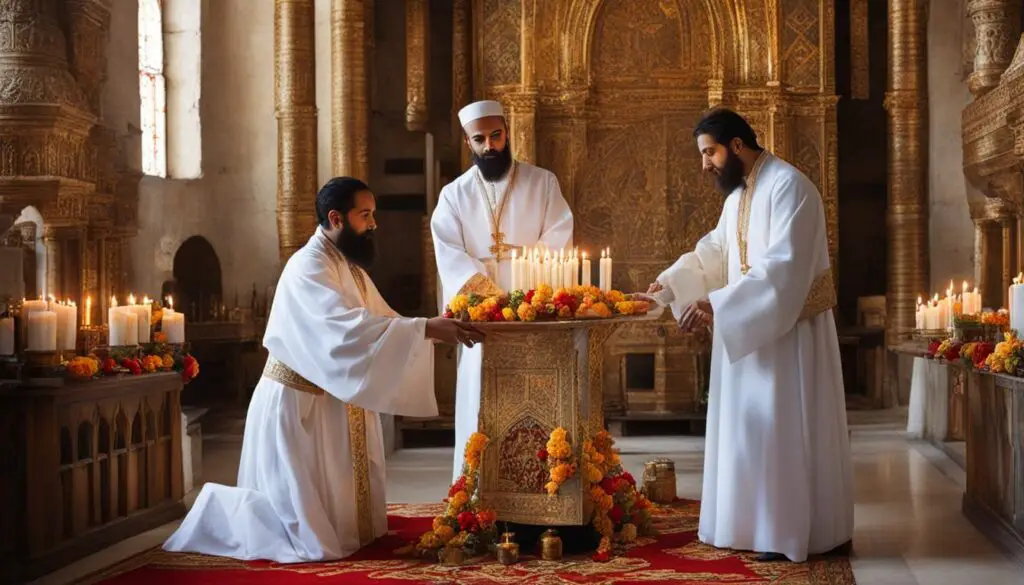
The Seven Sacraments
The Syriac Orthodox Church celebrates seven sacraments, each contributing to the spiritual growth and nourishment of its members:
- Baptism: The sacrament of initiation, which cleanses the individual from sin and welcomes them into the church community.
- Confirmation: A sacrament of the Holy Spirit, where individuals receive the gifts of the Spirit to empower them in their Christian journey.
- Eucharist: The sacrament of the Holy Communion, where the faithful partake in the body and blood of Christ, symbolizing their union with Him.
- Confession: A sacrament of repentance and reconciliation, where individuals confess their sins and receive absolution from a priest.
- Anointing of the Sick: A sacrament for the healing of the sick and the offering of spiritual comfort and support.
- Holy Orders: The sacrament through which individuals are ordained as deacons, priests, or bishops to serve the church and its people.
- Matrimony: The sacrament of marriage, sanctifying the union between a man and a woman.
Rituals and Traditions
In addition to the sacraments, the Syriac Orthodox Church practices various rituals and traditions that enrich its worship:
- Use of Incense: Incense is a common element in Syriac Orthodox rituals, symbolizing the prayers of the faithful rising to heaven and purifying the worship space.
- Prayers for the Departed: The church holds prayers for the departed, emphasizing the belief in the communion between the living and the dead.
- Chanting and Hymns: The liturgical services of the Syriac Orthodox Church are accompanied by sacred chants and hymns, creating a reverent and transcendent atmosphere.
- Sign of the Cross: The sign of the cross is made frequently throughout the liturgy and other rituals, acknowledging the believer’s faith in the crucifixion and resurrection of Christ.
These sacraments and rituals form an integral part of the Syriac Orthodox Church’s spiritual life, fostering a deep connection with God and the community.
Leadership and Clergy
The Syriac Orthodox Church operates under a hierarchical structure led by the Patriarch of Antioch, who holds the esteemed position of the head of the church. The patriarchate of Antioch is recognized as one of the oldest apostolic sees, with a lineage tracing back to Saint Peter, the first bishop of Antioch. The patriarch serves as the spiritual guide, overseeing the governance and administration of the church.
To assist in the pastoral ministry and administration, the Syriac Orthodox Church has a hierarchy of bishops and priests who serve in various dioceses and parishes. Bishops play a crucial role in the church’s leadership, offering guidance, and ensuring the spiritual well-being of the faithful within their respective dioceses. They are responsible for ordaining priests, conducting liturgical services, and providing pastoral care to the community.
The clergy, including priests, carry out the day-to-day sacramental and liturgical functions of the church. Priests are ordained to serve specific parishes, where they oversee the regular worship services, administer sacraments, and provide pastoral guidance to the congregation. They play a vital role in nurturing the spiritual growth and well-being of the community.
In addition to the patriarchate of Antioch, the Syriac Orthodox Church in India has its own Catholicos, who carries out the spiritual leadership and administration within the Indian context. The Catholicos of India is accountable to the Patriarch of Antioch and represents the church’s interests in the region. This structure ensures the cohesive functioning of the church and fosters unity among the believers.
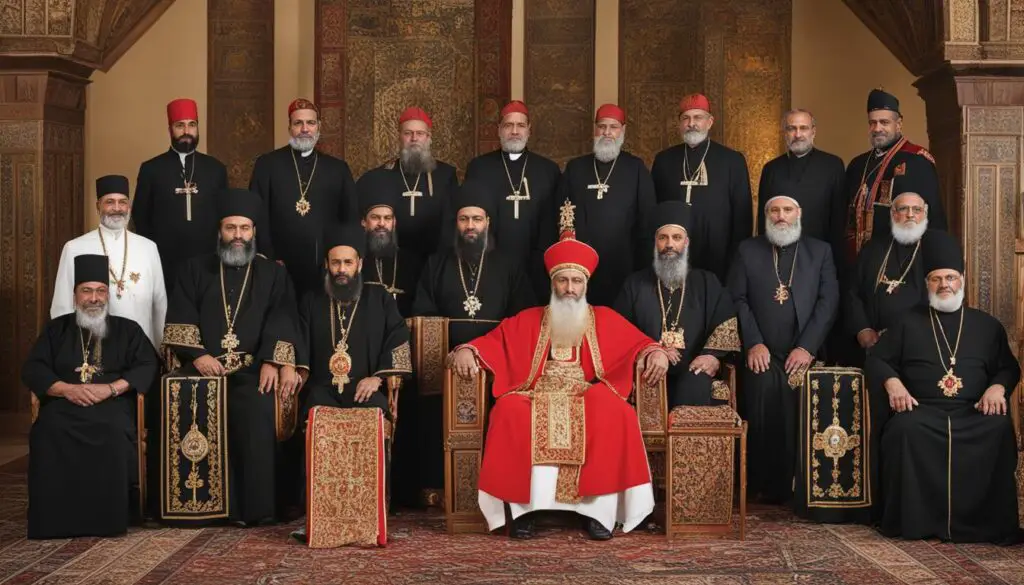
| Hierarchy Level | Responsibilities |
|---|---|
| Patriarch of Antioch | Head of the church, spiritual and administrative leader, apostolic succession from Saint Peter |
| Bishops | Oversee dioceses, consecrate holy orders, conduct liturgical services, provide pastoral guidance |
| Priests | Serve in parishes, administer sacraments, lead worship services, offer pastoral care to the community |
| Catholicos of India | Spiritual leader and administrator for the church in India, accountable to the Patriarch of Antioch |
Worship Practices
The Syriac Orthodox Church has a unique and sacred worship style that is deeply rooted in its ancient traditions. Central to its worship practices is the celebrated Liturgy of Saint James. This liturgical celebration holds great significance within the Syriac Orthodox community, serving as a solemn and transformative experience for the faithful.
The Liturgy of Saint James encompasses a rich tapestry of prayers, hymns, scripture readings, and rituals. These elements, enshrined in the Syriac language, create a deeply spiritual atmosphere that transports worshippers to a realm of divine connection and reverence.
The Syriac Orthodox Church places a strong emphasis on the active participation of the faithful during worship. It encourages congregational engagement through collective prayers, responses, and hymn singing. This interactive approach fosters a sense of unity and community, deepening the spiritual experience for all.
“In the Liturgy of Saint James, we find ourselves immersed in a profound encounter with the divine. It is a journey through time, connecting us with the roots of our faith and allowing us to experience the presence of God in a tangible way.” – Patriarch John X of Antioch
Liturgy of Saint James: Key Elements
To provide a deeper understanding of the Syriac Orthodox worship practices, the key elements of the Liturgy of Saint James are summarized in the table below:
| Element | Description |
|---|---|
| Prayers | A collection of ancient prayers, including the Trisagion, Lord’s Prayer, and various intercessory prayers, offered by the priest and the congregation |
| Hymns | Soul-stirring chants and hymns sung in the Syriac language, praising God and reflecting on the mysteries of the faith |
| Scripture Readings | Selected passages from the Holy Bible, bringing forth the Word of God and providing spiritual nourishment to the worshippers |
| Rituals | Symbolic actions performed by the priest, such as the offering of incense, the sprinkling of holy water, and the elevation of the Eucharist, conveying deeper spiritual meanings |
The Liturgy of Saint James serves as a powerful testament to the Syriac Orthodox Church’s devotion to preserving its ancient traditions and connecting worshippers with the divine. Through this unique worship experience, the Syriac Orthodox faithful continue to find solace, inspiration, and a profound sense of spiritual renewal.
Sacred Texts
The Syriac Orthodox Church cherishes the Peshitta version of the Bible as its sacred text. The Peshitta, an ancient Syriac translation of the Bible, holds immense reverence among scholars and within the church community. Its versions of the Old and New Testaments serve as a source of spiritual guidance and wisdom for Syriac Orthodox Christians.
Translated directly from the original Hebrew and Greek texts, the Peshitta has been pivotal in preserving the biblical message and teachings in the Syriac language. Its authenticity and accuracy make it a primary resource for biblical study, worship, and theological interpretation within the Syriac Orthodox tradition.
Furthermore, the Syriac Church Fathers have made significant contributions to biblical translations and interpretations. These wise and erudite scholars have played a fundamental role in shaping the understanding and application of the sacred texts. Their diligent efforts have not only impacted the Syriac Orthodox Church but have also gained recognition and respect within the wider Christian world.
“The Peshitta Bible stands as a testament to the timeless message of God’s love and redemption. It serves as a precious treasure for Syriac Orthodox Christians, guiding and inspiring them in their faith journey.”
Biblical Translations and Interpretations by the Syriac Church Fathers
| Syriac Church Father | Notable Contributions |
|---|---|
| Saint Ephrem the Syrian | Renowned for his hymns and poetic exegesis of Scripture. |
| Saint Jacob of Serugh | A master of metaphorical and spiritual interpretation of biblical texts. |
| Saint Philoxenus of Mabbug | Known for his Syriac translations and commentaries on the Scriptures. |
| Saint Cyril of Alexandria | Contributed to the translation of the Peshitta and offered deep insights into Christology. |
Their profound scholarly work and devotion to preserving the biblical message continue to be valued by the Syriac Orthodox Church and symbolize the lasting impact of the Syriac Church Fathers on Christian theology.
Denominations and Sects
The Syriac Orthodox Church has a diverse history, characterized by divisions and schisms that have shaped its denominations and sects. One notable division is the formation of the Malankara Jacobite Syrian Orthodox Church in India.
The Malankara Jacobite Syrian Orthodox Church emerged from a historical dispute within the Syriac Orthodox community, resulting in a separate hierarchy and distinct traditions. Despite the schism, the Malankara Jacobite Syrian Orthodox Church remains in communion with the Syriac Orthodox Church, sharing a common faith and spiritual heritage.
“The establishment of the Malankara Jacobite Syrian Orthodox Church in India testifies to the resilience and adaptability of the Syriac Orthodox community. It reflects the vibrant diversity within the global Syriac Orthodox Church.”
This denominational difference has also influenced the geographic distribution of the Syriac Orthodox community. While the Syriac Orthodox Church is predominantly present in the Middle East, the Malankara Jacobite Syrian Orthodox Church has a significant presence in India, with a growing number of faithful in the diaspora.
These divisions and schisms, although challenging, have contributed to the evolution and identity of the Syriac Orthodox community. The various denominations and sects within the Syriac Orthodox Church continue to uphold their distinctive traditions while remaining rooted in their shared Syriac Orthodox beliefs and heritage.
Contemporary Issues and Challenges
The Syriac Orthodox Church, rooted in ancient traditions and beliefs, faces numerous contemporary issues and challenges in today’s world. One of the most pressing challenges is the ongoing persecution experienced by the Syriac Orthodox community in certain regions. Despite being a peaceful and inclusive religious group, members of the church have been subjected to discrimination, violence, and displacement, threatening their safety and well-being.
The impact of political conflicts in the Middle East and beyond has also posed significant challenges to the Syriac Orthodox Church. These conflicts have resulted in the destruction of churches, displacement of worshippers, and disruption of religious practices. As a result, the church has had to adapt to new circumstances and find ways to support its members amidst the turmoil.
Another challenge faced by the Syriac Orthodox Church is the dispersion of its diaspora communities. Many followers of the church have migrated to different parts of the world, seeking better opportunities and refuge from persecution. This dispersion has led to the formation of new Syriac Orthodox communities in various countries, each with their unique set of challenges and the need for cultural preservation and integration.
To address these challenges, the Syriac Orthodox Church actively engages in ecumenical and theological dialogues with other Christian denominations. By fostering unity and collaboration among believers, the church seeks to find common ground and advocate for justice and peace in the face of persecution and conflict. This commitment to dialogue and interfaith cooperation helps the church navigate the contemporary landscape and stay true to its ancient faith and traditions.
FAQ
What is the history of the Syriac Orthodox Church?
The Syriac Orthodox Church of Antioch is one of the oldest established apostolic churches, tracing its roots back to the followers of Jesus in Antioch. It has a rich history and is known for its unique Semitic form of Christianity.
How did the Syriac Orthodox Church originate and establish?
According to ecclesiastical tradition, the Syriac Orthodox Church originated in Antioch, where the followers of Jesus were first called Christians. St. Peter the Apostle established a bishopric in Antioch, and the church flourished under the leadership of successive bishops and patriarchs.
What are the beliefs and doctrines of the Syriac Orthodox Church?
The Syriac Orthodox Church upholds the doctrine of miaphysitism, which teaches that Christ has one incarnate nature from two natures. This is in contrast to the Chalcedonian teaching that Christ has two distinct natures, human and divine.
What sacraments and rituals are central to the Syriac Orthodox Church?
The Syriac Orthodox Church celebrates seven sacraments, including baptism, confirmation, Eucharist, confession, anointing of the sick, holy orders, and matrimony. Various rituals and traditions, such as the use of incense and prayers for the departed, are central to its worship practices.
Who leads the Syriac Orthodox Church and what is its hierarchy?
The Syriac Orthodox Church is led by the Patriarch of Antioch, who is the head of the church. The church also has a hierarchy of bishops and priests, who serve in various dioceses and parishes. The church in India has its own Catholicos, who is accountable to the Patriarch of Antioch.
What are the worship practices of the Syriac Orthodox Church?
The Syriac Orthodox Church has a distinct worship style, with the liturgy of Saint James being the central liturgical celebration. The liturgy includes prayers, hymns, scripture readings, and rituals, all performed in the Syriac language. The faithful actively participate in prayers and responses.
What are the sacred texts of the Syriac Orthodox Church?
The Syriac Orthodox Church holds the Peshitta version of the Bible as its primary sacred text. The Peshitta is an ancient Syriac translation of the Bible, and its versions of the Old and New Testaments are highly respected. The Syriac Church Fathers have also made significant contributions to biblical translations and interpretations.
Are there any denominations or sects within the Syriac Orthodox Church?
Yes, one prominent example is the establishment of the Malankara Jacobite Syrian Orthodox Church in India, which has its own hierarchy and traditions but remains in communion with the Syriac Orthodox Church.
What contemporary issues and challenges does the Syriac Orthodox Church face?
The Syriac Orthodox Church faces challenges such as persecution in some regions, the impact of political conflicts, and the dispersion of its diaspora communities. It actively engages in ecumenical and theological dialogues to address these challenges and promote unity among believers.


